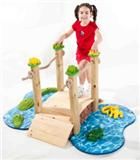What is Kinesthetic Learning?
Most of the school population excels through kinesthetic means: touching, feeling, experiencing the material at hand. "Children enter kindergarten as kinesthetic and tactual learners, moving and touching everything as they learn. By second or third grade, some students have become visual learners. During the late elementary years some students, primarily females, become auditory learners. Yet, many adults, especially males, maintain kinesthetic and tactual strengths throughout their lives."(Teaching Secondary Students Through Their Individual Learning Styles, Rita Stafford and Kenneth J. Dunn; Allyn and Bacon).
Kinesthetic learners are most successful when totally engaged with the learning activity. They acquire information fastest when participating in a science lab, drama presentation, skit, field trip, dance, or other active activity. Because of the high numbers of kinesthetic learners, education is shifting toward a more hands-on approach; manipulatives and other "props" are incorporated into almost every school subject, from physical education to language arts. Hands-on teaching techniques are gaining recognition because they address the challenging needs of kinesthetic learners, as well as the diverse needs of auditory and visual learners.
The experienced educators and much of the peer-reviewed literature stated that kinesthetic techniques are particularly beneficial for underachieving students, students at risk of academic failure, and students with attention deficit hyperactivity disorder (ADHD).
 As elementary students a few decades ago, we learned to read, write, add and subtract sitting at desks aligned in neat rows, looking at dittos with faded purple ink. This traditional set up may have worked for us, but undoubtedly did not work for everyone. Today, teachers are expected to engage all their students, allowing them to learn with all their senses and to move purposefully around the classroom as part of the learning process. Experienced educators understand this and frequently employ kinesthetic methods in their lessons. Not every lesson lends itself to this type of teaching, but many do. For inexperienced teachers who are unsure of how to incorporate physical activity into their academic lessons, experienced teachers are excellent sources of ideas. So are books, the internet, and the students themselves. Kinesthetic methods may excite our students about the material they are studying, and thus may lead not only to better behavior, but better learning as well.
As elementary students a few decades ago, we learned to read, write, add and subtract sitting at desks aligned in neat rows, looking at dittos with faded purple ink. This traditional set up may have worked for us, but undoubtedly did not work for everyone. Today, teachers are expected to engage all their students, allowing them to learn with all their senses and to move purposefully around the classroom as part of the learning process. Experienced educators understand this and frequently employ kinesthetic methods in their lessons. Not every lesson lends itself to this type of teaching, but many do. For inexperienced teachers who are unsure of how to incorporate physical activity into their academic lessons, experienced teachers are excellent sources of ideas. So are books, the internet, and the students themselves. Kinesthetic methods may excite our students about the material they are studying, and thus may lead not only to better behavior, but better learning as well.

